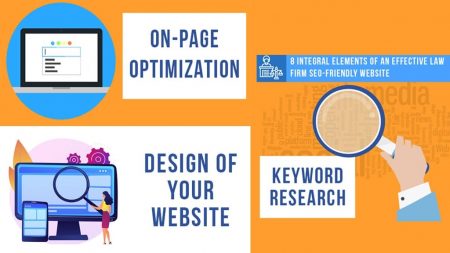 Both creative and strategic approach is important for law firms to attract new clients. It thus becomes important to have an SEO-Friendly Website. As we know Search Engine Optimization commonly known as SEO is important if you are looking to drive traffic and convert them into clients. However, the entire process of having an optimized law firm website isn’t that easy.
Both creative and strategic approach is important for law firms to attract new clients. It thus becomes important to have an SEO-Friendly Website. As we know Search Engine Optimization commonly known as SEO is important if you are looking to drive traffic and convert them into clients. However, the entire process of having an optimized law firm website isn’t that easy.
Legal is a very competitive niche that demands lawyers and technical sensitivity. It thus becomes important for law firms to take a creative and strategic approach to attract more clients from Search Engines. You would be happy to know that the fundamentals of building a law firm SEO-friendly website are consistent and straightforward.
How Important is SEO for a Law Firm Website?
- Increases visibility of your law firm and helps in finding potential clients
- Helps to outrank both local and national level competitors by compelling users to select your law firm over others
- Improves reputation by highlighting positive reviews published by previous clients
- Drive consistent traffic and regular clients
Important 8 Components for Optimizing Your Law Firm Website
Let us now discuss some important elements to consider when creating an SEO-Friendly website and rank at the top on organic search results.
Keyword Research
Any SEO strategy is incomplete without doing keyword research and is highly important in the competitive legal niche. The primary goal when optimizing your website should be to find keywords with high search volume but mid or low-competition keywords. The combination is perfect for increasing the chances of ranking on those keywords.
Specific targeting is important and you should select keywords that are related to your specialization. For instance, your selection of specific keywords can be product liability claims, criminal defense, family law, or employment law. If you target keywords like “Lawyer in Florida” then it would be too broad to rank but if you target the keyword “[practicing area] lawyer in Tampa” it will be a lot easier to rank.
Design of your Website
The structure of a website and ease of navigating are important for effective SEO implementation. Websites loading quickly is intuitive and simplifies access to information they are searching for. It also improves the aspect of crawl ability for search engines. Best practices of a lawyer SEO-friendly website include:
- optimizing site-speed,
- using simple fonts &
- compressed images
- implementing intuitive design
- adding call-to-action buttons
- integrating custom graphics
- internally linking relevant pages and posts
- ensuring contact forms or clickable links are working and not leading to 404 pages
Authority and Branding
Your brand has to stand out to beat competitors and to do so you need to invest in an attractive website, professional logo, and high-quality photography. Other essential things include using brand colors and fonts on the website. You need to decide what your law firm represents and how you have to communicate with prospective clients. For this, you have to work with a professional branding consultant and a copywriter who can help in developing the mission and USP of your brand.
Technical Aspects of SEO
Lawyer SEO indeed is technical and your website needs to abide by the parameters or best practices listed by Search Engines. In case you have the best-looking website backed by effective branding but not a structurally sound design, it will be difficult to rank higher on the search engines. Some important things to ensure this isn’t your case are:
- Have an intuitive URL structure
- Fix 404 pages and redirect them to live pages (301 redirects)
- Submit sitemap to search engines
- Enable SSL (HTTPS://)
- Ensure your website’s design is mobile-friendly
- Integrate Google Search Console and Google Analytics
On-Page Optimization
Integrate the keywords you derived after doing the keyword research in the 1st step. It involves selecting a primary keyword for your pages and posts. Each of these pages should also be integrated with related keywords (find them using the keyword research tools). Next, you should be having the primary keyword in the title tag, in the H1 tag, and the secondary keywords in the body content focused to provide accurate and valuable information. Other things involved adding internal and external links and including high-quality images.
Off-Page Optimization
Off-Page optimization or placing your website is done by local optimization business directory listings), review generation (published on Google My Business), and link building (backlinks from reputed websites).
Optimizing Conversion
The target of SEO is not entirely traffic, leads and revenue. Conversion optimization while developing your website increases the chance of converting traffic to actual clients. For this, you have to consider the kind of experience of your users. You should ensure information is available easily on the website, users can contact you quickly, provide case studies and past success stories, etc.
Content Marketing
Last but not the least, publish content on your website and post them as a blog. Integrate a multi-channel marketing strategy to get the best from the content you publish. To make this successful you should be sharing your post on social media or sending emails to your subscribers. Publishing informative videos on your YouTube channel is a trending source for generating more traffic through content. Ensure you are writing or developing content that is meaningful and useful for both your audience and search engines.
If you are searching for a professional SEO and Web Marketing company in Tampa, FL, you can contact Affordable SEO Company. They specialize in optimizing and creating websites that improve branding and rank you better on search engines.
